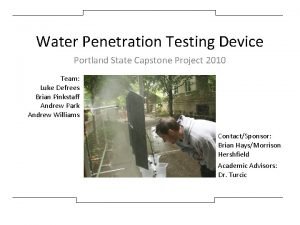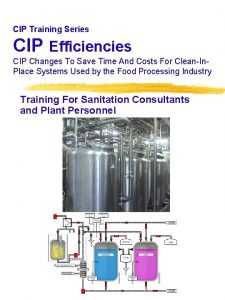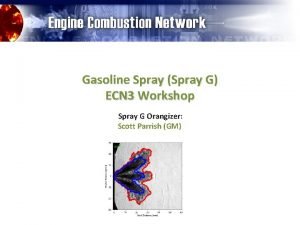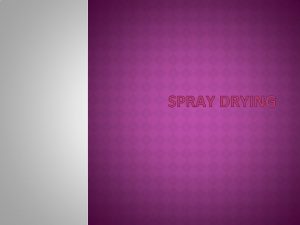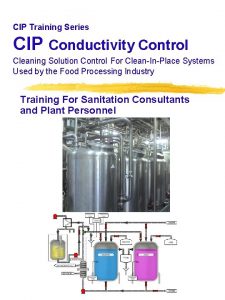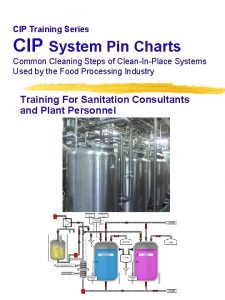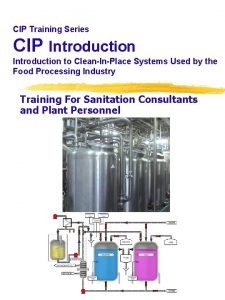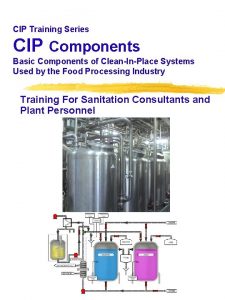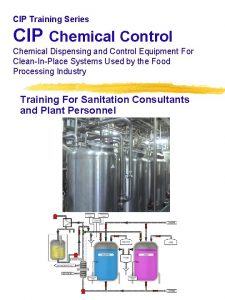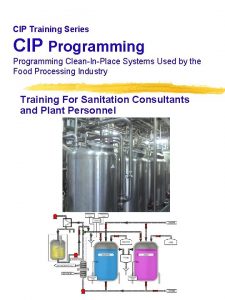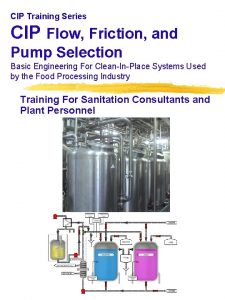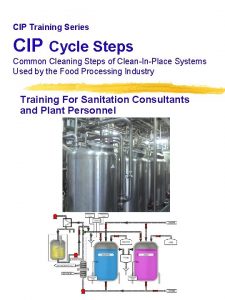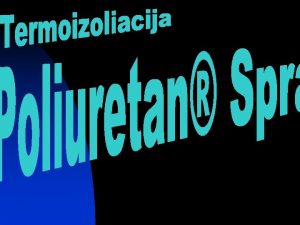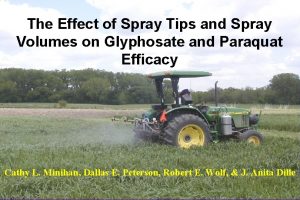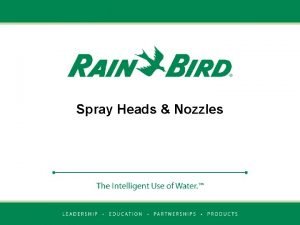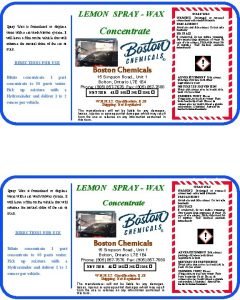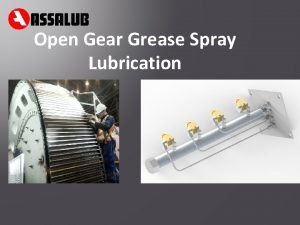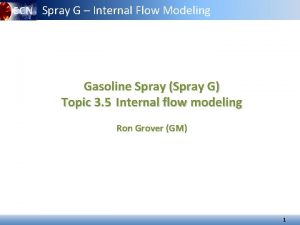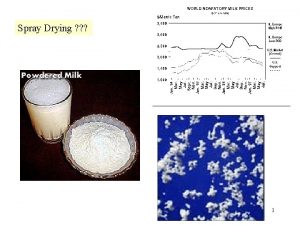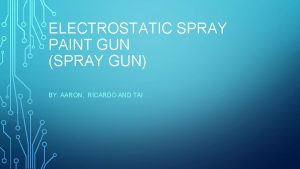CIP Training Series CIP Spray Devices For CIP





































- Slides: 37

CIP Training Series CIP Spray Devices For CIP System Cleaning of Clean-In. Place Systems Used by the Food Processing Industry Training For Sanitation Consultants and Plant Personnel

CIP Spray Devices Types of Spray Heads There are many types of spray devices and spray nozzles. However, there are basically 2 types of spray devices used in the food and pharmaceutical industries: z Fixed Spray Devices z Rotating Spray Devices Fixed devices are used most frequently in the food industry and other sanitary applications. Rotating devices require periodic maintenance and can shed particulates (due to wear and tear). However, they are also used in the food industry.

CIP Spray Devices Selecting Spray Heads Choosing the right spray device -Questions to consider z What is the tank or vessel size? The device must provide spray coverage over all interior surfaces. z What is the product stored or processed in the vessel? y The product nature can affect the difficulty of soil removal and thus require more spray devices or a special type of spray device. z What is the condition of the soil (is it allowed to dry onto surfaces, becoming encrusted)? z Are there any obstructions such as agitators and/or baffles? These can shadow areas of the vessel. z Are there any internal areas that require coverage, such as inlet sockets, manholes, and probes? y The spray device may not cover these areas well; manual cleaning may be required. z What is the fill level of the vessel? Sprayball Rotating Jet Tank Cleaner Illustrations from Tuchenhagen

CIP Spray Devices Selecting Spray Heads Choosing the right spray device-for coverage of all surfaces z Example of vessel bottom mixer (notice the agitator shaft) z Example of vessel baffles

CIP Spray Devices Fixed Spray Heads How fixed spray devices clean z Fixed sprays generally operate at lower pressures than rotating devices. Only the interior top of the tank or vessel requires spray contact. The remainder of the vessel is contacted by the flow of the solution through gravity. This is referred to as ‘cascading’ or ‘sheeting’. z The CIP detergents react with and solubilizes soils. They may improve the wetting of surfaces to help loosen the soils. z The flow of the solution down the interior walls of the tank or processing equipment at sufficient velocity and flow volume through sheeting action flushes the soils away. This works particularly well for vertical tanks.

CIP Spray Devices Fixed Spray Heads How fixed spray devices clean [Most silos have a sprayball with multiple holes located at the top of the vessel. Another type of spray device has a fixed pipe/nozzle located at the vessel bottom. It sprays a single jet stream that impacts the silo top (center) and the solution runs down the sidewalls. ] z A fixed nozzle for tall (vertical) silos may have this “Spray-Up” technology. y To achieve good results from bottom jets: x The CIP pump must deliver the proper flow and pressure. z Advantages: More accessible than sprayballs and less prone to plugging. z Disadvantages: The nozzle must be directed to the top-center of the silo. Even if it is slightly angled there may be areas that do not receive the cascading flow, leaving soiled areas.

CIP Spray Devices Fixed Spray Heads There are quite a number of fixed or static spray devices. These include: z Spray Balls z Inverted Dishes z Drop-In-Sprays z Bubble Sprays z Disks z Rings z Retractable spray nozzles Spray heads from various equipment suppliers will be shown [such as Sani-Matic, Tuchenhagen (GEA), and Evaporator Dryer Technologies, Inc].

CIP Spray Devices Spray Heads Numerous Types Available A few are shown below Ball Disc Ring Inverted Dish Orbital

CIP Spray Devices Types of Spray Heads The fixed spray devices find use in a number of applications. z Spray balls are used to clean tanks, process vessels, silos, etc. z Dishes are used to clean evaporators and silos. Rings are also used to clean evaporators z Drop-In-Spray devices are used in food plant receiving bays for the CIP of tankers z Disks are used to clean (vertical) process vessels and silos z Bubble sprays are used to CIP duct work (dryers, etc. ) z Retractable nozzles can clean a variety of vessels

CIP Spray Devices Type - Sprayballs z Sprayballs come in a variety of configurations z Top, bottom, or side locations z Multiple spray devices are used as needed for complete coverage y The sprayball can be located in the top, bottom, or side of a vessel. Likewise, holes can be up, down, or at the side of a sprayball, directing the spray pattern as needed. z Multiple sprays can be placed in separate inlet ports or mounted on cross-tube assemblies z Spray devices are self-cleaning and selfdraining z Material of construction for sanitary applications are 304, 316, and 316 L stainless steel z Inlet connections commonly 1 -2” z Sprayball connection allows for easy removal for inspection and cleaning z Inlet connections typically slip on sleeve with a pipe clip (the clip is hooked into the bores of the insertion pipe via the bores of the sleeve)

CIP Spray Devices Flows & Pressures [Spray devices are supplied by the manufacturers with flow ratings at a given pressure. The flow rate through a spray device is dependent on the size of the holes (and number) and the supply pressure (provided by the CIP supply pump). ] z CIP pressures typically need to approximate 25 psi for many sprayballs. z Rotating devices require higher pressures, since cleaning is dependent on impingement (versus cascading flow of sprayballs). z If sprayballs are operated at pressures and flows that exceed their design ratings, atomization of the spray can occur, providing ineffective cleaning results. z If pressures and flows are too low, the spray stream is also ineffective, as the spray may not reach the surface to be cleaned.

CIP Spray Devices Flows & Pressures Cont. Consult each manufacturer for the proper engineering (sizing) of pumps and use of any restricting orifices. z Supply and return flowrates should be balanced. Flow rates into and out of the vessel must be balanced for flow. Consideration of the sprayball to be used should take flow balances into account. z The CIP system should be able to supply the proper flow and pressure to the sprayballs being used. z The CIP system should be able to document flows and/or pressures.

CIP Spray Devices Types of Spray Heads z The hole pattern in the sprayball is available according to the application (sidewall, top, and/or bottom spray direction) Alfa Laval sprayballs pictured

CIP Spray Devices Spray Heads Critical Component Questions z What is the equipment geometry and dimensions? z What pressures will be needed for rinsing and cleaning the equipment? z Are there plant water consumption limits? z What is the optimal placement and orientation of the spray head(s)? [In most cases the equipment manufacturer will design the proper number and type of spray devices into their equipment. Any competent CIP supplier should be able to engineer the CIP system for the piece of equipment. ]

CIP Spray Devices Spray Heads z What is the spray ball/head recommended for a given application z What is the orientation and spray pattern? z What flow rates and pressures are required through the spray ball? To get a general idea of the device required, refer to Table 1 & Table 2 on the next 2 pages

CIP Spray Devices Spray Heads For CIP Spray Heads Designed For Food Process Equipment z Static Spray Balls Information on orientation, flow rates, pressures, applications From Adams & Agarwal, Bio. Pharm, Jun 89, Clean-In-Place System Design

CIP Spray Devices Spray Heads For CIP Spray Heads Designed For Food Process Equipment z Static and Dynamic Spray Heads y “Dynamic” are rotational devices From Adams & Agarwal, Bio. Pharm, Jun 89, Clean-In-Place System Design

CIP Spray Devices Spray Heads Static Spray Balls/Heads z Cleaning by flow—sheeting action of falling film at proper flow rate y Supplying solution at a free falling film Reynolds number of 200 for proper fluid flow z Pressures must be <30 psi to minimize atomization z Spray ball pressure of 20 -25 psi is common. Supply 0. 1 -0. 5 gpm/ft 2 of surface area for cleaning

CIP Spray Devices Static Spray Heads Example of CIP Spray Components z Spray Balls and Discs y Permanently installed in sanitary tanks y Spray discs used for special applications such as flat-top and open tanks—must be removed after each use y Vessels larger than effective spray ball diameter require multiple spray balls Model Spray Pattern Application SB-1 Upward Effective 6’ radius (Vertical, dome top, or horizontal tanks) SB-2 Upward-horizontal mount, 2 on tee 16’ length or less (Horizontal tanks) SB-3 Custom Special patterns, flow in ducts, tanks with baffles and agitators SB-4 Downward Vertical, open top tanks SB-5 360° Special requirements (Baffles, agitators) Sani-Matic Chart of sprayball Models versus spray patterns and applications

CIP Spray Devices Static Spray Heads z Typical Applications: Spray Balls (Sani-Matic diagrams of sprayballs in various applications) Vertical Tanks With closed or open tank (12’ diameter typical) SB-1 SB-4 (Sani-Matic) Single assembly (up to 16’ long) SB-2 (Sani-Matic) Horizontal Tanks SB-1 (Sani-Matic) Multiple assemblies at 12’ intervals

CIP Spray Devices Static Spray Heads z Typical Applications (Sani-Matic diagrams of sprayballs in various applications) Special Applications Side views Large pipelines or ducts Agitator and Baffles - Top view Multiple spray heads required for tanks with agitators and/or baffles

CIP Spray Devices Spray Balls A Few Spray Ball Models - Sani-Matic Components Upward Spray Pattern Spray pattern for vertical, dome top, or horizontal tanks Effective 6’ radius 40 - 80 gpm @25 psi Model SB-1 For horizontal tanks 16’ or less 40 gpm each 80 gpm total @25 psi Model SB-2

CIP Spray Devices Spray Balls A Few Spray Ball Models - Sani-Matic Components Various Applications Spray pattern for special installations in ducts, tubes, stacks, tanks with baffles and/or agitators, etc. Custom spray pattern (Specify gpm at desired pressure, ball diameter, connection size) Model SB-3 -S Vertical open tanks Downward spray 40 gpm @25 psi Model SB-4 Tanks with special requirements along sidewall or bottom (with baffles or agitator) - 360° spray 40 gpm @25 psi Model SB-5

CIP Spray Devices Spray Discs A Few Spray Ball Models - Sani-Matic Components (Flowrates adjustable to 150 gpm) Various Applications Upward Spray For loose covered vessels Spray sidewalls and upward to include cover Model SK-1 Upward and downward Spray For loose covered vessels Spray sidewalls and upward to include cover and downward for coverage of agitator Model SK-2 Downward Spray For open top vessels Spray sidewalls and downward for coverage of agitator Model SK-3

CIP Spray Devices Spray Heads Example of Sani-Matic CIP Spray Components z Spray Discs y Special applications as listed in table below y Tabular Summary (as shown in previous slide) Model Spray Pattern Application SK-1 Holes in top Vessels loose covered Spray directed to sidewalls Spray upward for cover SK-2 Holes in top & bottom Vessels loose covered with agitator Spray directed to sidewalls Spray upward for cover Spray downward for agitator SK-3 Holes in bottom Vessels open top Spray directed to sidewalls Spray downward for agitator

CIP Spray Devices Spray Heads z Typical Applications: Spray Discs (from Sani-Matic) Covered & Sidewall Light upward spray Model SK-1 Cover, Sidewall & Agitator Light upward and downward spray Model SK-2 Sidewall and Agitator Downward spray and multiple sprays Required Model SK-3

CIP Spray Devices Spray Heads - Design Summary Selection of Spray Pattern z Depends on application z Spray is directed at top 1/3 of vessel z Cascading film falls over lower surfaces y Side view of cascading in tank from spray ball in dome z High volume sheeting to erode product soil/residue z More than one spray device is needed to provide complete coverage if the tank or vessel is larger than the effective spray range of the spray device (such as long/large horizontal tanks)

CIP Spray Devices Spray Heads - Design Summary Selection of Spray Pattern z Internal components may require 2 spray devices or directing spray in another way z Shape, size, and configuration of equipment determines location, number, and type of spray balls z Locate spray balls as close as possible to vessel center axis z If there are baffles in the vessel, it may require more than one spray ball y In diagram below – There is only one spray ball. A top view of the vessel with agitator and baffle plates shows “shadowing” (brown areas) caused by these spray obstructions. y If you go back to the bottom of slide 21, you can see how two spray devices should be properly located in this type of vessel in order to achieve complete coverage. Multiple spray devices required to overcome the “shadow” effects

CIP Spray Devices Spray Heads Selection of Spray Pattern z Whether static or rotating, 360° coverage is needed z Silos/vessels may not be cleaned by spray balls. y May have spray pipe/nozzle mounted in bottom y Spray shoots up to dome of silo and cascades down y Be careful of proper alignment. If slightly off center it may result in partially soiled surfaces after CIP

CIP Spray Devices Rotating Spray Heads z Rotating spray heads use a high pressure impingement mechanism instead of the sheeting action that lower pressure spray balls use. Thus, rotating spray heads have lower flow rates. z Sprayballs cover all of the interior surfaces with a constant flood; whereas rotating spray nozzles direct a small pinpoint spray to a small surface area as the spray device rotates eventually covering all inside surfaces. z Control of the wash cycle time is important to ensure coverage of all surfaces.

CIP Spray Devices Rotating Spray Heads Rotating spray heads are used less frequently than sprayballs in sanitary situations in food plants. There are many designs of rotating devices, including: rotary jets, turbines, rotary arms and others. Rotary jets must have several revolutions to provide complete surface coverage and impingement. Others provide coverage with one revolution. These devices rotate by one of several means: z CIP flow (through a turbine) which drives rotating gears. z Rotation due to flow through off-center holes. z Rotary jets driven by motors of some type (electric, hydraulic, pneumatic-air).

CIP Spray Devices Rotating Spray Heads Rotating spray heads find use in cleaning tanks that may have soil incrustations, such as fermentation tanks and mixing tanks. z As opposed to sprayballs the rotating jet spray does not wet all surfaces at the same time; the solution impinges on a portion of the tank with a focused jet spray and stream of solution down the walls. y The energy of the jet acts on the impinged surface. A thicker liquid film is formed. Flow to the vessel outlet has higher energy and cleaning may be improved. y The speed of the sprayhead is a function of the solution volume in the supply pipe and the flow velocity. Illustration from Tuchenhagen

CIP Spray Devices Rotating Spray Heads Mechanically Driven Spray Heads z Cleaning by impingement at higher pressures (>50 psi) y Sprayballs ≈ 20 -25 psi z Use lower flow rates (<10 gpm) y Sprayballs ≈ 80 gpm z Covers all surfaces of vessel by controlling direction of nozzles and by controlling length of wash cycle z If all surfaces are not hit directly by spray, vessel may not get clean z More effective for cleaning equipment where the soils are GEA more adherent to equipment Devices surfaces requiring more concentrated spray force to dislodge the soils (e. g. , dryers, flour tankers).

CIP Spray Devices Mechanically Driven Spray Heads Example of Sani-Matic CIP Spray Components z Drop-In Tanker Washer y Designed to CIP interior of tankers from 20 to 44 ft. y Spray washer is clamped in place in the manway and sprays overhead and front/back head surfaces y Material is 304 stainless y Supply requirement is 120 gpm and 40 psi y Can see from the diagram how the spray pattern works in a long tanker

CIP Spray Devices Spray Heads - Misc. Varieties Retractable Sanitary Spray Head z Nozzle spray head makes a wide spray of swirling jets z Solution activated spray head extends during CIP and retracts after CIP, allowing it to remain in place during production z After CIP process, CIP supply line is air blown/purged to remove any product/solution residue z Can be removed for inspection From EDT, Inc. 316 L stainless Flush Mount Ferrule Mount Double-Wall Flush Mount

CIP Spray Devices Summary A wide variety of spray devices are available. Consider the factors that influence spray device selection, including: soil type, CIP system, and vessel being cleaned. Your CIP supplier will select the best type and model of spray device for your equipment applications.

CIP Training Thank you for your time! Questions?
 Spray rack calibration
Spray rack calibration Maclaurin series vs taylor series
Maclaurin series vs taylor series Balmer series lyman series
Balmer series lyman series Taylor series of composite functions
Taylor series of composite functions Maclaurin series vs taylor series
Maclaurin series vs taylor series P series ibm
P series ibm Shunt-series feedback amplifier
Shunt-series feedback amplifier Series aiding and series opposing
Series aiding and series opposing Sum of infinite series formula
Sum of infinite series formula Iso 22301 utbildning
Iso 22301 utbildning Typiska drag för en novell
Typiska drag för en novell Tack för att ni lyssnade bild
Tack för att ni lyssnade bild Returpilarna
Returpilarna Shingelfrisyren
Shingelfrisyren En lathund för arbete med kontinuitetshantering
En lathund för arbete med kontinuitetshantering Särskild löneskatt för pensionskostnader
Särskild löneskatt för pensionskostnader Vilotidsbok
Vilotidsbok Anatomi organ reproduksi
Anatomi organ reproduksi Vad är densitet
Vad är densitet Datorkunskap för nybörjare
Datorkunskap för nybörjare Tack för att ni lyssnade bild
Tack för att ni lyssnade bild Att skriva debattartikel
Att skriva debattartikel Delegerande ledarstil
Delegerande ledarstil Nyckelkompetenser för livslångt lärande
Nyckelkompetenser för livslångt lärande Påbyggnader för flakfordon
Påbyggnader för flakfordon Lufttryck formel
Lufttryck formel Offentlig förvaltning
Offentlig förvaltning I gullregnens månad
I gullregnens månad Presentera för publik crossboss
Presentera för publik crossboss Argument för teckenspråk som minoritetsspråk
Argument för teckenspråk som minoritetsspråk Kanaans land
Kanaans land Klassificeringsstruktur för kommunala verksamheter
Klassificeringsstruktur för kommunala verksamheter Luftstrupen för medicinare
Luftstrupen för medicinare Bästa kameran för astrofoto
Bästa kameran för astrofoto Centrum för kunskap och säkerhet
Centrum för kunskap och säkerhet Byggprocessen steg för steg
Byggprocessen steg för steg Bra mat för unga idrottare
Bra mat för unga idrottare Verktyg för automatisering av utbetalningar
Verktyg för automatisering av utbetalningar
